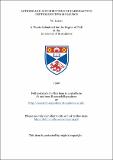Files in this item
Actions and distributions of cardioactive peptides in two molluscs
Item metadata
| dc.contributor.advisor | Cottrell, Glen A. | |
| dc.contributor.author | Lesser, W. | |
| dc.coverage.spatial | 119 p. | en_US |
| dc.date.accessioned | 2018-06-22T11:19:28Z | |
| dc.date.available | 2018-06-22T11:19:28Z | |
| dc.date.issued | 1990 | |
| dc.identifier.uri | https://hdl.handle.net/10023/14456 | |
| dc.description.abstract | 1. All seven FMRFamide peptides endogenous to Helix aspersa stimulate perfused cardiac ventricles isolated from aestivating Helix. The five heptapeptide amides (pQDPFLRFeimide, NDPFLRFamide, NDPYLRFamide, SDPFLRFamide and SEPYLRFamide) are equipotent with each other, but more potent than the two tetrapeptide amides (FMRFamide and FLRFamide). 2. The two endogenous nonapeptide amide SCPs (small cardioactive peptides: SGYLAFPRMamide and MNYLAFPRMamide) are also cardioactive in Helix. They are more potent than the heptapeptides. All nine peptides increase the beat amplitude or beat strength rather than affecting the beat frequency. 3. The potency ratio between the activities of FLRFamide and FMRFamide on ventricles from aestivating Helix is significantly different (p=0.001) from that of this peptide pair on ventricles from active animals. 4. RIA analysis of extracts fractionated by HPLC indicate that all nine peptides are present in the circumoesophageal ganglia (brain), the combined visceral and anal nerve trunks, and the anterior aorta. 5. Similar analysis of the heart shows that the tetrapeptides and SCPs are present in the heart; the heptapeptides are absent. 6. Immunohistochemistry reveals a diffuse FMRFamidergic innervation spread evenly throughout the heart. Two clusters of neurones (one each in the left and right parietal ganglia) of the brain also stain positively with FMRFamide antiserum. 7. Calcium-dependent release of the FMRFamide peptides from the brain and the heart has been demonstrated. 8. The perfused cardiac ventricle isolated from Eledone cirrosa is stimulated by the FMRFamide analogues in the reverse order to that of the Helix ventricle; FMRFamide is the most potent, FLRFamide is slightly less potent, and the heptapeptides are the least potent. Six unidentified FMRFamide-immunoreactive peaks are present in the nervous tissue (brain, optic lobes and vena cava); two of these peaks are probably FMRFamide and FLRFamide. 9. The tetrapeptides (but not heptapeptides) reversibly reduce a calcium conductance in the C1 neurone of Helix: this current may be required for transmitter release. This effect may explain presynaptic inhibition by FMRFamide (cf. Haydon &, Man-Son-Hing, 1988; Haydon Sc Zoran, 1989). | en_US |
| dc.language.iso | en | en_US |
| dc.publisher | University of St Andrews | |
| dc.subject.lcc | QP552.P4L3 | |
| dc.subject.lcsh | Peptides | en |
| dc.title | Actions and distributions of cardioactive peptides in two molluscs | en_US |
| dc.type | Thesis | en_US |
| dc.contributor.sponsor | University of St Andrews | en_US |
| dc.type.qualificationlevel | Doctoral | en_US |
| dc.type.qualificationname | PhD Doctor of Philosophy | en_US |
| dc.publisher.institution | The University of St Andrews | en_US |
This item appears in the following Collection(s)
Items in the St Andrews Research Repository are protected by copyright, with all rights reserved, unless otherwise indicated.

